Beaux-Arts
The same concept, in the somewhat more restrained form of allegorical sculpture and inscriptions, became one of the hallmarks of Beaux-Arts structures, and thereby filtered through to American civic architecture. One fine example is the 1901 New York Yacht Club building on 44th Street in Manhattan, designed by the team of Warren and Wetmore. Its three front windows are patterned on the sterns of early Dutch ships, and the façade fairly drips with nautical-themed applied sculpture. The same team designed the 1912 Grand Central Terminal, which also contains self-explaining architectural elements in the form of the oversized allegorical sculpture group, and in the ingenious way that the shapes, surfaces, steps, arches, ramps and passageways inherent in the structure constitute a language that helps visitors orient themselves and find their way through the building.
The same year, McKim, Mead & White designed the Farley Post Office Building with its famous inscription adapted from Herodotus: "Neither snow nor rain nor heat nor gloom of night stays these couriers from the swift completion of their appointed rounds."
The civic architecture of Washington, D.C. provides some of the most poetic and most verbose inscriptions. Beaux-Arts architect Daniel Burnham is responsible for the Washington Union Station (1908), with its inscription program developed by Harvard president Charles William Eliot. It includes over the main entrance this paean: "Fire: greatest of discoveries, enabling man to live in various climates, use many foods, and compel the forces of nature to do his work. Electricity: carrier of light and power, devourer of time and space, bearer of human speech over land and sea, greatest servant of man, itself unknown. Thou hast put all things under his feet."
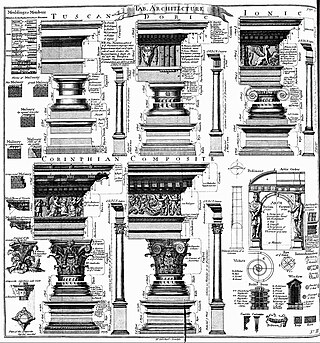
An order in architecture is a certain assemblage of parts subject to uniform established proportions, regulated by the office that each part has to perform. Coming down to the present from Ancient Greek and Ancient Roman civilization, the architectural orders are the styles of classical architecture, each distinguished by its proportions and characteristic profiles and details, and most readily recognizable by the type of column employed. The three orders of architecture—the Doric, Ionic, and Corinthian—originated in Greece. To these the Romans added, in practice if not in name, the Tuscan, which they made simpler than Doric, and the Composite, which was more ornamental than the Corinthian. The architectural order of a classical building is akin to the mode or key of classical music; the grammar or rhetoric of a written composition. It is established by certain modules like the intervals of music, and it raises certain expectations in an audience attuned to its language.
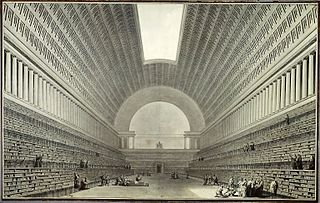
Étienne-Louis Boullée was a visionary French neoclassical architect whose work greatly influenced contemporary architects.
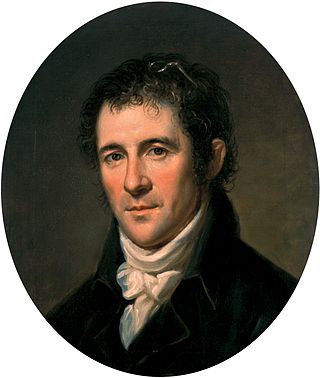
Benjamin Henry Boneval Latrobe was an Anglo-American neoclassical architect who emigrated to the United States. He was one of the first formally trained, professional architects in the new United States, drawing on influences from his travels in Italy, as well as British and French Neoclassical architects such as Claude Nicolas Ledoux. In his thirties, he emigrated to the new United States and designed the United States Capitol, on "Capitol Hill" in Washington, D.C., as well as the Old Baltimore Cathedral or The Baltimore Basilica,. It is the first Cathedral constructed in the United States for any Christian denomination. Latrobe also designed the largest structure in America at the time, the "Merchants' Exchange" in Baltimore. With extensive balconied atriums through the wings and a large central rotunda under a low dome which dominated the city, it was completed in 1820 after five years of work and endured into the early twentieth century.

Lee Oscar Lawrie was an American architectural sculptor and a key figure in the American art scene preceding World War II. Over his long career of more than 300 commissions Lawrie's style evolved through Modern Gothic, to Beaux-Arts, Classicism, and, finally, into Moderne or Art Deco.

Greek Revival architecure was an style which began in the middle of the 18th century but which particularly flourished in the late 18th and early 19th centuries, predominantly in northern Europe, the United States, and Canada, as well as in Greece itself following its independence in 1832. It revived many aspects of the forms and styles of ancient Greek architecture, in particular the Greek temple. A product of Hellenism, Greek Revival architecture is looked upon as the last phase in the development of Neoclassical architecture, which was drawn from Roman architecture. The term was first used by Charles Robert Cockerell in a lecture he gave as an architecture professor at the Royal Academy of Arts in London in 1842.

The architecture of the United States demonstrates a broad variety of architectural styles and built forms over the country's history of over two centuries of independence and former Spanish, French, Dutch and British rule.
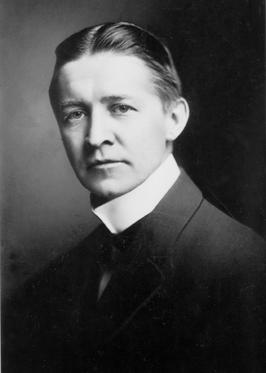
Bertram Grosvenor Goodhue was an American architect celebrated for his work in Gothic Revival and Spanish Colonial Revival design. He also designed notable typefaces, including Cheltenham and Merrymount for the Merrymount Press. Later in life, Goodhue freed his architectural style with works like El Fureidis in Montecito, one of the three estates designed by Goodhue.

The Nebraska State Capitol is the seat of government for the U.S. state of Nebraska and is located in downtown Lincoln. Designed by New York architect Bertram Grosvenor Goodhue in 1920, it was constructed of Indiana limestone from 1922 to 1932. The capitol houses the primary executive and judicial offices of Nebraska and is home to the Nebraska Legislature—the only unicameral state legislature in the United States.
Mayers, Murray & Phillip was an architecture firm in New York city and the successor firm to Goodhue Associates, after Bertram Goodhue's unexpected death in 1924. The principals were Francis L.S. Mayers,Oscar Harold Murray, and Hardie Phillip.

Neoclassical architecture, sometimes referred to as Classical Revival architecture, is an architectural style produced by the Neoclassical movement that began in the mid-18th century in Italy and France. It became one of the most prominent architectural styles in the Western world. The prevailing styles of architecture in most of Europe for the previous two centuries, Renaissance architecture and Baroque architecture, already represented partial revivals of the Classical architecture of ancient Rome and ancient Greek architecture, but the Neoclassical movement aimed to strip away the excesses of Late Baroque and return to a purer and more authentic classical style, adapted to modern purposes.

Jean-Jacques Lequeu was a French draughtsman and architect.
Hartley Burr Alexander, PhD (1873–1939), was an American philosopher, writer, educator, scholar, poet, and iconographer.

Visionary architecture is a design that only exists on paper or displays idealistic or impractical qualities. The term originated from an exhibit at the Museum of Modern Art in 1960. Visionary architects are also known as paper architects because their improbable works exist only as drawings, collages, or models. Their designs show unique, creative concepts that are unrealistic or impossible except in the design environment.
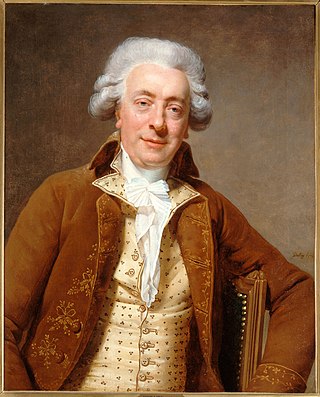
Claude-Nicolas Ledoux was one of the earliest exponents of French Neoclassical architecture. He used his knowledge of architectural theory to design not only domestic architecture but also town planning; as a consequence of his visionary plan for the Ideal City of Chaux, he became known as a utopian. His greatest works were funded by the French monarchy and came to be perceived as symbols of the Ancien Régime rather than Utopia. The French Revolution hampered his career; much of his work was destroyed in the nineteenth century. In 1804, he published a collection of his designs under the title L'Architecture considérée sous le rapport de l'art, des mœurs et de la législation. In this book he took the opportunity of revising his earlier designs, making them more rigorously neoclassical and up to date. This revision has distorted an accurate assessment of his role in the evolution of Neoclassical architecture. His most ambitious work was the uncompleted Royal Saltworks at Arc-et-Senans, an idealistic and visionary town showing many examples of architecture parlante. Conversely his works and commissions also included the more mundane and everyday architecture such as approximately sixty elaborate tollgates around Paris in the Wall of the General Tax Farm.

Architectural sculpture is the use of sculptural techniques by an architect and/or sculptor in the design of a building, bridge, mausoleum or other such project. The sculpture is usually integrated with the structure, but freestanding works that are part of the original design are also considered to be architectural sculpture. The concept overlaps with, or is a subset of, monumental sculpture.
Jean-Laurent Le Geay was a French neoclassical architect with an unsatisfactory career largely spent in Germany. His artistic personality remained shadowy until recently, though he was allowed to have had numerous pupils among the avant-garde of neoclassicism. He won the Prix de Rome in architecture in 1732, which, after an unaccountable delay, sent him for study to the French Academy in Rome from December 1738 to January 1742, when the Director, Jean François de Troy, remarked of him on his departure "il y a du feu et du génie". After he returned to Paris, there is no record of him, but about 1745 he was in Berlin, where he published eight etchings (1747–48) of plans and elevations for St Hedwig's Church, Berlin, which he produced in collaboration with Georg Wenzeslaus von Knobelsdorff, until recently the chief architect to Frederick II of Prussia; the church was eventually built to a modified version of the plan, by Johann Boumann, from June 1748, and Johann Gottfried Büring, in 1772–3.
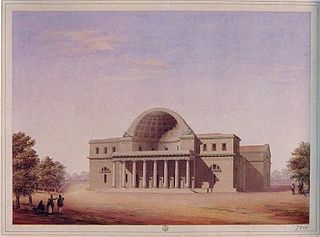
The Cisternoni of Livorno are a series of three large buildings in the neoclassical style at Livorno, in Tuscany, Italy. They were constructed between 1829 and 1848 as part of a complex of purification plants and storage tanks to the Leopoldino aqueduct; a fourth cisternone planned at Castellaccia was never built. The cisternoni, literally "great cisterns", provided Livorno — a city that is still today one of the principal ports of the Mediterranean — with fresh and, more importantly, clean water throughout the 19th and 20th centuries.
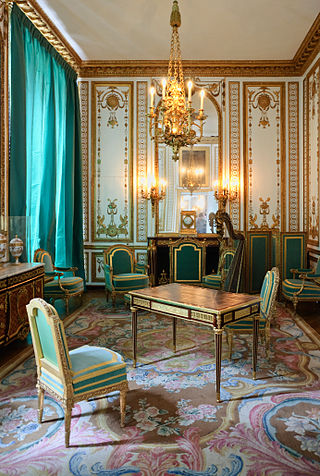
Louis XVI style, also called Louis Seize, is a style of architecture, furniture, decoration and art which developed in France during the 19-year reign of Louis XVI (1774–1793), just before the French Revolution. It saw the final phase of the Baroque style as well as the birth of French Neoclassicism. The style was a reaction against the elaborate ornament of the preceding Baroque period. It was inspired in part by the discoveries of Ancient Roman paintings, sculpture and architecture in Herculaneum and Pompeii. Its features included the straight column, the simplicity of the post-and-lintel, the architrave of the Greek temple. It also expressed the Rousseau-inspired values of returning to nature and the view of nature as an idealized and wild but still orderly and inherently worthy model for the arts to follow.
Emil Kaufmann was an Austrian art and architecture historian. He was the son of Max Kaufmann, a businessman, and Friederike Baumwald (Kaufmann). Kaufmann is best known for his studies of neo-classicism.

Neoclassicism is a movement in architecture, design and the arts which was dominant in France between about 1760 to 1830. It emerged as a reaction to the frivolity and excessive ornament of the baroque and rococo styles. In architecture it featured sobriety, straight lines, and forms, such as the pediment and colonnade, based on Ancient Greek and Roman models. In painting it featured heroism and sacrifice in the time of the ancient Romans and Greeks. It began late in the reign of Louis XV, became dominant under Louis XVI, and continued through the French Revolution, the French Directory, and the reign of Napoleon Bonaparte, and the Bourbon Restoration until 1830, when it was gradually replaced as the dominant style by romanticism and eclecticism.
















